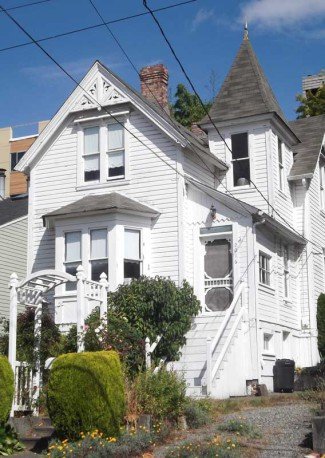14th Ave W Houses
In August 2013, we almost lost the Gilman House to a menacing developer. Just as soon as the Queen Anne Historical Society learned that an offer had been accepted on the Gilman House, the oldest building of the historic Fourteenth Avenue West Group (identified as historic & documented by Historic Seattle), and that demolition (probably in the middle of the night) was likely, it moved swiftly. Although alarmed by the idea of demolition, the Society was even more distressed to learn that the bank foreclosing on the house and the realtor selling it both knew about the building’s landmark designation and had suggested that it could be ‘delisted.’
Notifying the Department of Neighborhood’s Historic Preservation section and Historic Seattle’s Director of Preservation Advocacy, the Queen Anne Historical Society put into motion the legal tools that protect the building and which eventually encouraged the potential buyer to withdraw the purchase offer in the third week of August. It was bad and probably unethical for the bank and the realtor to suggest that the house could be removed from the City’s list of designated buildings or that Historic Seattle would abrogate its easement responsibilities. The City just doesn’t remove historic designation from a building, and Historic Seattle simply opens itself up to lawsuits if it doesn’t enforce its obligations.
A Finnish History
In 1891, one block from the recently completed Gilman House at 2016 14th Ave. W., the lazy tides of Smith Cove still lapped the beach, and the trains of the recently completed Seattle, Lake Shore and Eastern Railroad clipped by on a trestle on their eventual way to Snoqualmie Falls.
Today the beach is gone, probably buried with fill dug up between 1911 and 1917 to create the Lake Washington Ship Canal and the trestle replaced by the tracks of the Great Northern on the same fill.
Before Gilman’s Addition (a real estate subdivision), Gilman House and Gilman Drive, a diagonal street cut across Interbay’s mud flats intersecting with the railroad tracks at a place called Finn Town.
Indeed, Finnish people settled early on along 14th Avenue West, attracted by easy access to the water and the fishing that sustained their community, both here and before in Europe. The Gilman House was part of the waterside working-class Finnish community until after 1900 when Slavic immigrants settled there.
A Special Group of Homes
The 14th Avenue West group consists of the five houses north of Newton Street on 14th Avenue West. The Gilman House is the oldest, and a rare survivor of the architectural style that gave our neighborhood its name. Its Queen Anne features are found in the simple cross gables with decorative scrollwork that nestle a rectangular tower and the projecting bay on the front.
The four other designated houses reflect late Victorian styles, some with fancy scroll saw cut gable ends and wide porches. The neighbor to the south, the 1901 Torbactia house at 2014 14th W., is nearly identical in plan to the Gilman house, but it is missing the characteristic tower.
These houses, along with those at 2000, 2006 and 2010 14th W., achieved landmark designation in 1978 and are among the earliest buildings in the city to be designated. The houses are now City landmarks. Although landmarked simultaneously, this cluster is an exceptional Seattle example of multiple buildings that do not form a historic district.
At the time of designation, three of the houses belonged to Historic Seattle, the city’s only historic preservation organization. Historic Seattle has long been the protector of the city’s historic built environment, frequently taking on large and challenging projects such as the Wallingford’s Good Shepherd Center or more recently Washington Hall on 14th Avenue at Fir Street in the Central District.
Historic Seattle often acquires properties at risk and then resells them with easements that protect from unwise alterations or, in the worst case, demolition. That is what Historic Seattle did to protect the three 14th Ave. W. properties it owned.
Fortunately, the folks owning the two other houses, the recently threatened Gilman House and the Torbactia House, also favored landmark designation and assigned protective façade easements to Historic Seattle.
Still Not Safe
Of course, any owner can place an easement on a property. The easement usually runs in perpetuity. The big issue with an easement is finding someone to enforce it.
2010 - 14th Ave. W
Easements placed on buildings can restrict any number of changes. They are certainly not limited to historic matters, and they definitely don’t require designation as a city landmark. In the case of designated landmarks, the easements assure a second set of eyes protecting historic buildings.
Easements may change a property’s value. In some instances, the difference in value gives owners a possible charitable, tax-deductible expense. Historic Seattle requires an easement fee to monitor protected properties.
The five houses document an important period in Queen Anne and Seattle’s history when simple vernacular houses were built by working class people. All five houses merit protection, even more now on the 25th anniversary of their landmark designation than in 1978. The Queen Anne Historical Society will continue to watch these important vernacular structures and vigilantly prevent demolition or serious alteration.
The story doesn’t have a happy ending yet, but Gilman House is back on the market, and there is every hope that a sympathetic buyer will come along who is eager to protect this historic landmark.
The morning and evening rush hour traffic along 15th Avenue W. may be all that is left of Smith Cove’s diurnal changes, but all Queen Anne residents (uppers and uptowners) are delighted knowing that the five houses that once witnessed its tidal ebb and flow still stand.



